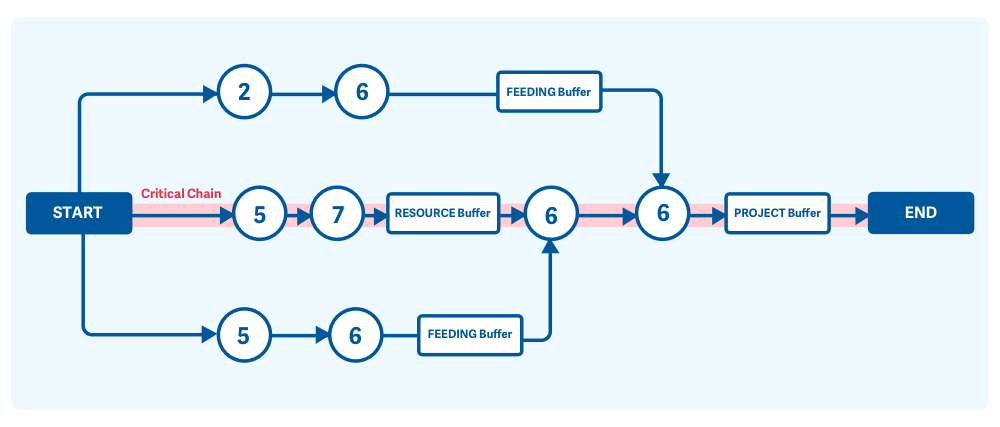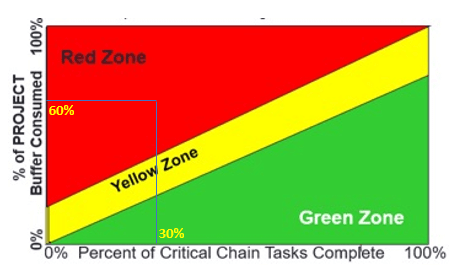Critical Chain Project Management Homework Help
Critical Chain Project Management (CCPM)
Critical Chain Project Management is an approach for arranging, executing and overseeing ventures in single and multi-venture conditions.
Critical Chain Project Management was created by Dr Goldratt and was first acquainted with the market in his Theory of Constraints book "Basic Chain" in 1997. It was created in light of numerous activities being hounded by lackluster showing showed in longer than anticipated terms, much of the time missed due dates, expanded expenses in overabundance of spending plan, and generously less expectations than initially guaranteed. A few of these constraints are listed out below:

Task durations are often overestimated by the Team Members or Task Owners. This is typically done to add a safety margin to the task so as to be certain of its completion in the decided duration.
In most cases, the tasks should not take the time estimated, which includes the safety margin, and should be completed earlier.
If the Safety Margin assumed is not needed, it is actually wasted. If the task is finished sooner, it may not necessarily mean that the successor task can start earlier as the resources required for the successor task may not be available until their scheduled time. Hence, the saved time cannot be passed on to finish the Project early. On the other hand, if there are delays over and above the estimated schedules, these delays will most definitely get passed on, and, in most cases, will exponentially increase the Project Schedule.
Example:
The Critical Chain length is 100 days, so when using 50% buffer sizing the Project Buffer duration would be 100 x 50% = 50 days
We have consumed the buffer of 30 days since there are only 20 days remaining.
So, buffer consumed = 30/50 = 60%
Also, Percent of critical chain task complete = 30/ 100 = 30%

From the fever-hart, it is definite that we are in the red zone. Intervention is necessary.
The Critical Path Project Management characterizes three sorts of Buffers -
Project Buffer
- The absolute pooled cradle appeared above is alluded to as the Project Buffer.
Feeding Buffer
- In a Project Network, there are way/s which feed into the Critical way. The pooled cushion on each such way speaks to the Feeding Buffer to the Critical Path bringing about giving some slack to the basic Path.
Resource Buffer
-This is a virtual assignment embedded just before basic chain undertakings that require basic assets. This goes about as a trigger point for the asset, demonstrating when the basic way is going to start. Differences between the critical chain approach and traditional scheduling approach
1. Schedules worst-case venture intervals. Schedules usual venture periods. Venture times do not accumulate security time "fudge reasons". Chance, stress, and effort are shared equally amongst all duties & assets. Humans begin to think otherwise than earlier than. "Sacred cow" schedules are avoided. Humans can see what's quite consuming the elapsed time. Administration can manage, assignment intervals are cut, people can go turbo with much less stress. Everyone and each useful resource are treated relatively & by way of the identical ideas. Ineffective hierarchies are broken down.
2. Protects individual tasks with safety time. Protects overall mission completion with buffers. Protection time shouldn't be hoarded by way of person duties and men and women, but shared by every person. Security time is conserved and used most wisely over the entire mission. Focus is placed on what is primary to the client: speedy deliverables.
3. Emphasizes challenge progress. Emphasizes venture development. Every person sees the "significant image". Micro-administration is refrained from. Challenge Managers have a steady outlook by means of the entire mission. Activities that gradual the assignment are constantly in the time table spotlight. Persons stay excited by the problems. Issues get identified more speedily, and get solved.
4. Starts gating duties ASAP. Begins gating tasks after they ought to. Valuable and limited resources aren't plugged up with non-principal tasks which block & slow principal tasks. That is similar to hearth Lanes and sirens on emergency vehicles. Non-critical traffic stays off the roads until the emergency vehicles have passed. Use of bottleneck assets is established on priority, no longer "first come, first served". Projects get accomplished faster.
5. Begins and finishes tasks at scheduled and conclude instances. Begins tasks as quickly as predecessors are performed, finishes tasks as swiftly as feasible. Undertaking is managed and carried out like a relay race. The baton normally goes across the monitor at highest velocity. Runners percent themselves for hand-offs so the baton never stops nor slows down. If you are carrying the baton, just finished carrying, or getting able to carry it subsequent, your movements are tightly monitored, managed, and managed; all others are of lesser priority and have freedom to self-manage. Folks focal point better, and projects get executed rapid and more cost-effective.
6. Makes resource competition a PM "reality of existence". Resolves useful resource contentions explicitly. Bottleneck resource is recognized by way of CCPM agenda. All users of the significant useful resource are identified up-front and conflicts resolved. Challenge Managers watch handiest the relevant useful resource; always focusing on what's foremost and stopping issues from taking place. Constraints are managed.
7. Makes multi-tasking a PM "truth of existence". Minimizes multi-tasking through atmosphere priorities. The terrible rate of multi-tasking is exposed. All personnel are expert on "dangerous multi-tasking". Humans hunt down & eliminate their own multi-tasking, multi-tasking forced on them by using others, and multi-tasking performed by way of others. This on my own can cut undertaking schedules elapsed time by up to 40%.
8. Reacts to uncertainty by altering priorities, expediting, and creating a new schedule. Manages uncertainty by way of monitoring effect of events on buffer consumption. Project schedules and their priorities stay steady. Individuals don't get burdened, nor misplaced as quite simply. The influence of one venture on all different tasks is minimized. Entire group stabilizes into busy and productive repute quo events, rather than chaos. Folks believe advantages from CCPM; they're more productive, much less annoyed, worried. Their contributions & efforts topic. Morale climbs.
9. Makes project linkages and constraints mirror ad hoc or ordinary scheduling selections. Makes challenge linkages and constraints reflect only bodily scheduling requirements. "Sacred cows" like "we have now continually finished it that way"
Project Management Tutorials
- Activity Based Costing
- Basic Quality Tools
- Benchmarking Process
- Cause and Effect Diagram
- Project Activity Diagram
- Project Charter
- Project Contract Types
- Project Cost Control
- Gantt Chart Tool
- PERT Estimation Technique
- Work Breakdown Structure
- Motivational Theories
- Project Kick-off Meeting
- Conflict Management
- Crisis Management
- Critical Chain Project Management
- Decision Making Process
- Monte Carlo Analysis
- Negotiation Skills
- Pareto Chart Tool
- Project Management Processes
- Project Manager Goals
- Project Portfolio Management
- Project Quality Plan
- Project Scope
- Project Management Software
- Project Time Management
- Capability Maturity Model (CMM)
- Critical Chain Project Management (CCPM)
- Critical Path Method (CPM)
- Earned Value Management (EVM)
- Enterprise modeling
- Event chain diagram
- Five Forces Analysis
- Graphical Evaluation and Review Technique (GERT)
- Inclusive Management
- Product Life Cycle
- Run chart
- Six Sigma
- Aggregate planning
- Budgeted Cost of Work Performed
- Business analysis
- Business Process Modeling (BPM)
- Event Chain Diagrams
- Gantt chart
- Henry Gantt
Project Management Case studies
- Project Management Methodologies
- Implementation of Project Management
- Project Management Cultures
- Project Management Organizational Structures
- Negotiating for resources In Project Management
- Project Management Estimating
- Project Management Planning
- Project Scheduling
- Project Execution
- Controlling Projects Case Study
- Project Risk Management
- Conflict management Case Study
- Morality and Ethics Case Study
- Managing Scope Changes Case Study
- Wage and Salary Administration
- Time Management Case Study
- Industry Specific Construction Case Study
Project Management Sample Assignments
Project Management Sample Solutions
Testimonials
Very affordable projects!! And that to submit before deadlines. Thanks for helping me in my database project and raising my grades. I have been able to secure good marks in my internal assessment only because of you. Read More

